“Costumes for Cyborgs_sound”
New body experience in sound and movement
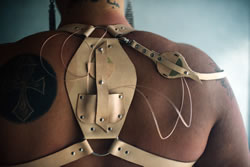
Costumes for Cyborgs_sound (CFC_s) creates performative articulation of the wearer’s movement, allowing new forms of sound to be produced with the body through biofeedback. By placing devices on our bodies, the piece asks the wearer to engage physically with Donna Haraway’s myth of the cyborg, which involves blurring lines between wearer and interface. In this engagement we allow for shifts and augmentations of the relationship to bodies, as well as creation of space for an expansion of the idea of body via non-biological tools. Piezoelectric elements pick up the physical vibration of the body. This data is mapped to frequencies, which then slide and shift with each movement, from nervous fidgeting to grand dramatic gestures. The sound feedback produced is a smoothly shifting frequency generated by an accompanying computer that modulates in response to the intensity and speed of the vibrations, to create an external expression of the wearer’s movement, allowing new forms of sound to be produced with the body. The volume is set at a point which allows the presence of the device to fall in and out of consciousness, providing the experience of wearing the device to be acknowledged by, as well as amalgamated with, the user’s physical body.
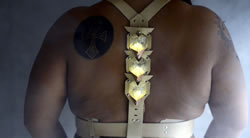

CFC_s is part of a larger project, Costumes for Cyborgs, investigating wearable technology as a form of movement feedback and the implications that forms of technological experience can have on self. The project is comprised of a pair of tan leather harnesses embedded with electronics. As the wearer moves, the devices give feedback, creating a loop of movement, technological reaction and finally movement, in response to this feedback. One harness creates this feedback using haptics: as the wearer twists their torso, switches are set off creating a cascade of vibrations from small vibrating motors down the back. The second harness, and focus of this article, gives the wearer auditory feedback. These devices can be envisioned as electronic prostheses, which articulate the movements of the wearer and augment the experience of the body’s movement (Video 1). The focal point of each piece is placed on the back of the wearer for two reasons. First, so as to be in contact with and register the movements of the spine. Second, this placement requires the wearer to make a conscious effort to be able to see the pieces using a mirror or camera. In the first instance, the intimacy between the wearer and the object allows the wearer to explore the ways in which body-centric technology can influence their sense of self and movement. In the second instance, the object blurs the boundaries between the conceptualization of self and tool. At any given moment the harness is not easily visually accessible to the wearer. Its functionality may only be accessed through the body’s movement and the reactive tactile and auditory feedback from the harnesses. This facilitates a subtle feeling of discomfort, a sensation that engages the wearer in questioning the root of this discomfort, further deepening our investigation and engagement of the body’s movement.
Gesture as External Voice
In Musicking, Christopher Small finds that gesture and relationship differ greatly from language as a means of communication. He coins the term “musicking” to broadly refer to any participation or interaction with the creation of sound. The idea of gesture is one image he uses to express the way in which musicking is enacted, and sound is communicated. Everyone involved in the context of this gesture is implicated in the act of musicking. Gesture is seamless, without gaps, where as in verbal language the relationship is arbitrary. He is by no means the first to discuss this important differentiation. He cites the English anthropologist Gregory Bateson and his dismissal of Cartesian dualism (a split between mind and body). Much of our perception of information is not only of the relationship between verbal language and sound, but also within the context of physical gestural language. Bateson has referred to these non-verbal forms of communication as a type of metamessage (context for our spoken verbal language full of arbitrary relationships). These metamessages give context to the message itself (Small 1998, 50–63). Many scholars have discussed these forms of communication, which come at a more physical level outside of language. Tor Norretranders refers to it as “exformation”, a meaning given when information is condensed into language. With the transfer of information, exformation is also created (Norretranders 1999). Eugene Gendlin uses the term “felt sense” to represent this embodied drawing of information from the context of conversations or knowledge exchange (Gendlin 1992). Each description has its own focus and nuance but each philosophizes the existence of a communicated meaning outside of our language. None devalue the act of synthesis, which happens when we create and use language as a form of communication, but rather acknowledge the vastness of the possibilities of engaging the physicality of gesture. It is these possibilities I seek to explore with CFC_s.
Each of these aforementioned theorists takes a differing approach to engage with ideas of higher levels of communication. For example, Gendlin takes a therapeutic approach, while Bateson investigates animal communication. As a software and electronics artist, I chose to engage with these ideas through the creation of wearable devices.
Designing Interactive Tools
In the process of building and crafting these objects, my connection to them grows in the same way that we connect closely to the tools that we use on a regular basis. We begin to notice nuances in their physical presence and shifts in their behaviour as tools. In this way, we gain a deep understanding of our experience with them. Our intimacy with our tools develops as our familiarity with them increases; I’ve tried to echo, enhance and play with this kind of relationship in the design on Costumes for Cyborgs in the realm of æsthetic considerations (creating a fashionable piece that is in itself a statement piece), as well as in the formal and material choice of leather (mimicking of the body’s form, fit and flesh).
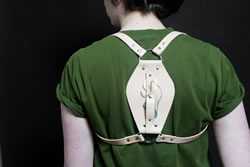
In the design process, the piece went through two iterations, allowing for user testing and feedback to be incorporated into the piece. The first iteration was a way of testing the type of sound the piece would make. Though simple frequency mapping seemed to bring out a great sense of play in the wearer’s movement, it only had one piezoelectric element. Allowing the data to come from two points on the body increased the sense of correlation between movement and sound feedback (Fig. 2). Creating moveable encasements for the sensors increased the agency for the wearer to choose the movement, which would trigger and shift the sounds created. Both iterations work through a system of piezoelectric elements connected through Bluetooth low energy to an OpenFrameworks application, which maps the movement data to sound frequencies. In developing the hardware design in parallel with the software, the process of creating the piece is informed and aided by a sort of feedback loop between the physical fabrication and software development activities. Creating a rough, wearable prototype is important in finessing the physical feel of the computationally created sound.
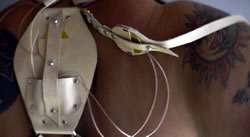

When individuals have been wearing the device for a certain amount of time, there is a perceptible shift in the complexity of their movements. With some experience they are able to create more nuanced sounds, using a greater variety and control of their physicality. Ivory, the model wearing the final device (Fig. 1, Videos 1–3), was shy at first, uncertain how to move. I’d chosen to work with her not only for her experience and talent as a model, but also because of her broad background in different types of movement, including dance, acting, professional fighting, yoga and horseback riding. When the software kicked in and her movement began making odd wheeling and screeching sounds, she was immediately delighted. In Videos 2 and 3 we can witness the learning process Ivory went through: beginning with simple movements and sounds and progressing to more this more nuanced articulation of her movements. At times she began responding with her own vocalizations. At one point the early un-optimized software cut out, and after a moment of confusion and disappointment she began recreating the sounds made by the computer using her own voice and kept moving accordingly, until my computer gained its composure and began humming again.
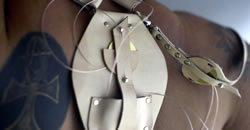

Integrating the Cyborg
In Musicking, Christopher Small points out the importance of relationship: “Relationships also are continuous and do not lend themselves to one-thing-at-a-time description” (Small 1998, 59). It is with this sentiment that I explore Haraway’s idea of the Cyborg, which takes comfort in irony and chaos. Haraway states: “This chapter is an argument for pleasure in the confusion of boundaries and for responsibility in their construction” (Haraway 1991, 150). The cyborg navigates the boundaries to understand, deconstruct and negotiate their existence.
In using the device, a relationship is built between the wearer and the device. As the wearer moves, the device creates sounds; these sounds act to create new and different moves. It is not the linear synthesized reproduction of a robotic player piano. This connection happens when a person well versed in the use of a tool wields that tool. This is the connection I aim to foster through interacting with CFC_s.
Costumes for Cyborgs explores Haraway’s cyborg narrative physically, by fostering an experience of possible new identity through an amalgamation of the wearer and the harness. This amalgamation is a push-and-pull relationship between the device and the wearer. By putting on the device, the wearer is exposed to the questions and ironies of the cyborg. The wearer must ask, for example, if the cyborg experience only takes place when these devices are worn, or if experiencing the cyborg in a conscious way affects the wearer beyond the temporal bounds of the experience. Is the wearer experiencing a performance of the piece, or are they performing for observers? If they are performing this piece, have they been amalgamated into the work that I, as creator, have produced?
Similarly to this cyborg relationship between user and tool, artists talk about this connection when using biodata in sound art. The different experiences these sound creators wish to facilitate is inevitably a more intimate experience of musicking: the musicking of pure gesture through biofeedback. In a performance context, the use of biofeedback as an instrument begins the process of engaging the audience in new ways with performance. For example, Claudia Robles discusses an experience performing with biofeedback, and the effect of the audience’s presence on the piece. In this instance, as the software levels were programmed at home, Robles experienced an important discrepancy: “[O]n stage for the first time, all the values were so high that I couldn’t really control them in the performance, it was impossible, the values were high all the time! I couldn’t do anything about it” (Lopes and chippewa 2013). The sound is varied according to the presence of relationships within the context of the sound production, and thus, the relationships within musicking are heard. But what does it mean to take this action of musicking though biofeedback and blur the boundaries of traditional sound performance? The experience of Costumes for Cyborg_sound aims to express this through physical gesture. If we make our devices act more like the articulation of high heels on a bare floor than that of an instrument to be performed in front of an audience, or if we open these devices up to be worn and experienced by those outside of traditional performance, how might this shift our exploration of the device? By blurring the boundaries of musicking with the cyborg experience we open possibilities of new sounds in body and movement.
Bibliography
Gendlin, Eugene. “The Wider Role of Bodily Sense in Thought and Language.” In Giving the Body its Due. Edited by Maxine Sheets-Johnstone. Albany NY: State University of New York Press, 1992, pp. 192–207.
Haraway, Donna. “A Cyborg Manifesto: Science, technology and Socialist-Feminism in the late twentieth century.” In Simians, Cyborgs and Women: The reinvention of nature. New York: Routledge, 1991, pp.149–181.
Lopes, Pedro and jef chippewa. “Performing Biological Bodies: An open conversation with Marco Donnarumma, Claudia Robles and Peter Kirn at Body Controlled #4 — Bio Interfacing.” eContact! 14.2 — Biotechnological Performance Practice / Pratiques de performance biotechnologique (July 2012). https://econtact.ca/14_2/lopes_bc4-interview.html
Norretranders, Tor. The User Illusion: Cutting consciousness down to size. New York: Penguin, 1999.
Small, Christopher. Musicking. Middletown: Wesleyan University Press, 1998.
Social top